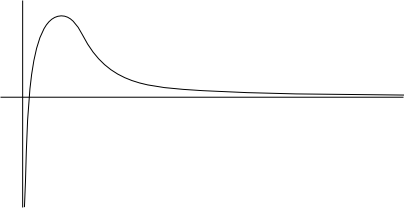For this particle system, I'm going to throw out any concepts of "quarks", "electrons", "atoms" and so on, and "orbits" which everyone has had so much trouble finding in 4D. I'm going to start completely from scratch and base my system upon just two "axioms":
1. There exists one fundamental kind of particle. I shall call this ε (epsilon). The symbol is arbitrary, I chose it only because the particle reminds me of electrons in some ways, but do not think that it is an electron, because it isn't.
2. There is a function which determines, non-linearly, a force which acts on one ε-particle as attraction or repulsion from an arrangement of other ε-particles. I won't define how this function works yet (if ever!), because I'm sure it's quite complicated and its behaviour is responsible for ensuring that everything works as it should. I'll describe the behaviour in a passive, somewhat macroscopic way throughout the post.
Okay, now that that's out the way, I'll get to describing how this system actually works.
Fundamentals
In the real world we are used to there being the concepts of "matter" and "energy" which are interchangeable through nuclear reactions and the like. Here, matter and energy are both formed by arrangements of ε-particles. I'll focus on energy first since it's much simpler. More specifically, energy is more or less equivalent to EM radiation, i.e. light, and travels in groups of six ε-particles. We can consider each 6ε group as one bigger particle which I'll call ɣ (gamma). Again the symbol is arbitrary, I chose it because gamma is a form of EM radiation in our universe. Now, from the frame of reference of a ɣ-particle, each ε-particle moves repeatedly in a circle, with a particular frequency (how many revolutions the particle makes in unit time) and amplitude (the radius of the circle). All six ε-particles in the same ɣ-particle have the same frequency and ampltude and their phase is synchronised in a certain way (which I can't describe very well, and this only matters because it allows a chiral property which will be important later).
The six circles in which the ε-particles move are all perpendicular to the direction the light is travelling. To define exactly how these are oriented I'll take a break from talking about the particle system to talk about a particular sequence of geometric shapes. This sequence has values for all dimensions of at least 2. For the value of dimension n, the process is as follows: (with the case n=3 in italics)
- Take a (n-1)-cube. (a square)
- Connect each vertex to the opposite vertex. (a square with two diagonals)
- Extrude the hypercube and connecting lines into the next dimension. (a cube with two perpendicular planes)
- Construct n copies of the connecting planes, oriented perpendicular to each axis. (six planes, each connecting pairs of opposite edges in the cube)
* Note that the resulting figure has n(2n-2) planes.
Now, each ε-particle orients itself into one of these six planes. The chiral property mentioned earlier determines which way the light travels (that is, forwards or backwards perpendicular to the cube).
Now, I've just defined one possible arrangements of ε-particles (the 6ε ɣ-particle). This arrangement is 3D, because the extra dimension is taken up by time. There is one other possible arrangement which is 4D. In general, with n time dimensions in the universe, there would be n+1 possible arrangements of ε-particles. However, I am only considering a universe with one time dimension, since there's really no need to boggle the mind with more than that. Anyway, the 4D arrangement is oriented in the same fashion, using the fourth value of the sequence, which has 16 planes. This arrangement forms matter, so I will call it μ. Notice that because a μ-particle is arranged in four dimensions, it does not have a direction to move in, so the chiral property cannot be reversed simply by "turning it around". Thus, the chiral property in this case actually introduces two distinct kinds of μ-particles, which I shall call μ+ and μ−.
Chemistry
μ-particles can be seen to act as the "atoms" of this particle system. However, once again, they are very different to the atoms we know. Firstly, a lone μ-particle is like a lone hydrogen atom: very reactive! It'll probably react in some way with the first thing it touches, in some cases even light itself. This property can be used to convert energy into matter. Secondly, groups of two or three μ-particles are completely unstable, and decompose as follows:
- a group of all μ+s or all μ−s will repel each other and fly off in opposite directions, becoming lone μs,
- μ+μ− will self-destruct, turning six such "molecules" into 16 ɣ-particles,
- μ+2μ− or μ+μ−2 will emit a lone μ of the majority kind and the remaining two μs will self-destruct as above.
This decomposition can be used to convert matter back into energy.
By this point you might be thinking "how do we form stable matter then?" This is done through four or more μ-particles in a "molecule". Generally (but not entirely), so long as there are at least two of each kind of μ-particle, the molecule will be stable enough to not spontaneously decompose, and the closer the ratio is to 1:1 the more stable it will be. There are a lot of possibilities here, most of which I haven't gone to the effort to work out yet. However, I've tried to identify gases up to 8μ so far (x:y means x of one kind and y of another, which kind is which does not matter) are:
- 2:2. This can exist in a square or tetrahedral arrangement (the two are completely equivalent).
- 2:3. This exists in a square pyramid or pentachoric arrangement. Is less stable than a 2:2.
- 2:4. This exists in a octahedral arrangement. Is more stable than 2:3, but less stable than 2:2.
- 3:3. This can only exist in a hexagonal arrangement and is the least stable so far. One of the counterexamples to the "closer the ratio is to 1:1" rule.
- 3:4. Exists in a "hexagonal + central cell" arrangement, is the most stable so far.
- 2:5. Exists as pentagonal bipyramid and is the least stable so far (less than 3:3).
- 4:4. Exists in a cubic arrangement and is quite stable. Not sure where to order it yet.
- 3:5. Not sure what form this would take yet.
- 2:6. The obvious choice is a hexagonal bipyramid like 2:5 but it'd be even less stable than that. There might be an alternative, more stable arrangement though.
I'll try and draw all these sometime, to show what I mean. And come up with possible chemical reactions.
Solids would likely be constructed from large tesseric lattices of alternating μ+ and μ− particles. There could probably be other forms of lattices.
Metals would be a special form of solid, whose "μ"-particles overlapped. So, they wouldn't be real μ-particles, as they would share ε-particles, and wouldn't be chiral. Electricity would occur as free ε-particles moving through the metal lattice.
Space
I wasn't going to say much on gravity or planets, but I'm quite confident the "force function" could be set up to allow stable planetary orbits, with momentum dictating radius. That way, knocking something out of orbit would likely place it in another orbit, and instead of a planet spiraling into or away from its star, it would likely move in and out of its "neutral" orbit with simple harmonic motion - like this:

This could create some interesting seasonal/weather phenomena - a civilization could use the orbital period as basis for their year, and the period of the SHM as basis for their week or month.
You could also have planets orbiting perpendicularly at the same radius, since there's an extra dimension to allow the orbits not to overlap. That would be interesting...


 (I'm no better - seeing how I just abandoned this forum for about a month!)
(I'm no better - seeing how I just abandoned this forum for about a month!)
